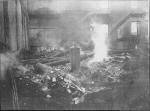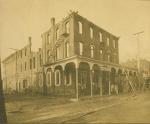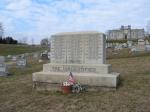![header=[Marker Text] body=[A disastrous fire destroyed the theater that stood at Philadelphia Ave. & Washington St. on Jan. 13, 1908. It claimed 170 victims, many buried here, due to overcrowding, poorly designed and unmarked exits, and inadequate fire escapes. The tragedy prompted the Pa. General Assembly to enact fire safety laws and improve construction and inspection standards, making public buildings safer and influencing similar legislation in other states.] sign](http://explorepahistory.com/kora/files/1/10/1-A-147-139-ExplorePAHistory-a0n3b6-a_450.jpg)
Mouse over for marker text
Name:
Rhoads Opera House Fire
County:
Berks
Marker Location:
Fairview Cemetery, north side of W Philadelphia Ave., Boyertown
Dedication Date:
June 29, 2008
Behind the Marker
At approximately 8pm, on January 13th, 1908, an audience of more than 300 townspeople packed the Boyertown Opera House to see the opening night performance of "The Scottish Reformation," a much-anticipated church-sponsored play that featured the latest slide projection technology and dramatic staging. Suddenly, during the second intermission, disaster struck. "There was a wild rush for the exits. Everybody seemed to have lost control," recalled survivor Reubon Stover. "The flames came towards the crowd like a great wave...once the crowd began to fight its way towards the doors no power on earth could have saved all the lives."
Just a few hours later, 170 people-one-tenth of the town's population–lay dead in and around the theater, and another seventy-five were seriously injured. In his official report, the coroner would state that the victims included 110 females, forty-three males, and twelve whose sex was not distinguishable. How could this have happened? Who was to blame? And what could be done to prevent a recurrence of one of the deadliest fires in American history?
It was Harry Fisher, an inexperienced projectionist, who had initially sparked the disaster when he turned the wrong knob on the projector, which emitted gas into the air. The hissing noise and the smell of gas soon alarmed the theatergoers, some of whom rushed towards the exit. When several of the actors peaked behind the muslin stage curtain to see what was causing the commotion, someone knocked over a kerosene lamp on the piano, which spilled flaming oil onto the front of the stage. The fire soon reached the kerosene tank that fueled the footlights, then set the curtain ablaze, which spread the fire to the wooden ceiling and the wainscoting along the wall.
Located on the second floor of the Rhoads Building, the Boyertown Theatre had only a single entrance at the foot of a narrow staircase, with double doors–one of which was bolted shut–that opened inward. As panicked people reached the theater's lone exit the crush of bodies wedged those in front against the closed door, trapping them all inside. "It was a battle in which only the strong had a chance to escape," Frank Cullen would later recall, as people fought with each other in their struggle to escape. Others threw themselves from the second story windows, hoping they might survive. In less than an hour more than 170 were dead.
On January 17th, 1908, only four days after the tragedy in Boyertown, an eighteen-year-old employee struck a match in the basement of the Imperial Underwear factory in Scranton, PA, which ignited a tipped-over glue pot and set off a fire that killed four young women, two of whom jumped to their deaths. With only one factory exit and a defective fire escape, many more workers received serious burns.
In turn of the century America, deadly fire like those at Boyertown and Scranton were all too common. Due to the extensive use of lumber, glues, oil based paints, gaslights, kerosene lanterns, and other highly flammable materials, factories, theaters, and other high occupancy buildings too often proved to be death traps. The advent of spotlight use in theatrical productions further compounded the danger, for the gases used to create limelight generated intense heat. So dangerous were nineteenth-century theaters that nearly 50 percent of them worldwide caught fire within the first ten years of their construction. The nation's deadliest theater fire occurred in 1903, only five years before the Boyertown Opera House Fire, at the Iroquois Theatre in Chicago, Illinois, when a defective lighting fixture set off an inferno that claimed 602 lives. Locked doors and unfinished fire escapes caused many of these deaths.
In the late 1800s, no state in the nation had done more to legislate for fire prevention than Pennsylvania. In 1869, Pennsylvania was the first state to pass mine safety legislation. A decade later it was the first state to require schools, hotels, hospitals, warehouses, factories, and tenements more than three stories tall to install fire escapes. In 1885, four years after some thirty people died in the Randolph Street mill fire in Philadelphia–most by jumping to their death to escape a building with no fire escape and only narrow stairwells–the state passed a law requiring that the fire escape must be constructed of iron and resemble regular stairs rather than rungs on a ladder.
In response to blocked windows with fire escapes, many of which were too high off the ground and especially difficult for women wearing the skirts of the day to use, the state passed a new law in 1893 requiring the construction of tower stairways, known as "Philadelphia Fire Towers" inside rather than outside tall buildings and factories, that could be sealed off.
Pennsylvania's factory and mine inspection and fire laws, however, were at best poorly enforced because of inspector incompetence and political influence, and fires were impossible to protect against entirely, as became clear in 1906, when the Mishler Theatre in Johnstown, built with twenty exits, sprinklers, and a fire-proof curtain, burned down when high winds swept a fire from an adjacent building into the belly of the theater.
Mishler Theatre in Johnstown, built with twenty exits, sprinklers, and a fire-proof curtain, burned down when high winds swept a fire from an adjacent building into the belly of the theater.
Forced to act by press coverage of the Boyertown and Scranton fires and growing public pressure the Pennsylvania State legislature passed new building fire safety laws in 1909. Act 206 required fireproof booths for projectors and stereopticons, even specifying the materials, size, flooring, ventilation, shelving, and wiring required for all projection booths. Two days later, Governor Edwin Stuart signed Act 233, which required easily accessible and visibly marked fire escapes, more than one exit from second floors, and doors that opened outward and remained unlocked in all theatres, public halls, and lodges with more than two stories. Subsequent legislation required panic bars installed inside all exits, fire resistant projection booths with two men on duty at all times, and properly marked exit signs at doors and fire escapes.
The Boyertown Opera House conflagration would not be the last great fire in Pennsylvania. The deadliness of fires, however, and the safety of buildings significantly increased during the Progressive era, when Pennsylvania and other state governments passed and more vigorously enforced laws to protect American workers, consumers, and the general public against preventable accidents, poisonings, and deaths.
Just a few hours later, 170 people-one-tenth of the town's population–lay dead in and around the theater, and another seventy-five were seriously injured. In his official report, the coroner would state that the victims included 110 females, forty-three males, and twelve whose sex was not distinguishable. How could this have happened? Who was to blame? And what could be done to prevent a recurrence of one of the deadliest fires in American history?
It was Harry Fisher, an inexperienced projectionist, who had initially sparked the disaster when he turned the wrong knob on the projector, which emitted gas into the air. The hissing noise and the smell of gas soon alarmed the theatergoers, some of whom rushed towards the exit. When several of the actors peaked behind the muslin stage curtain to see what was causing the commotion, someone knocked over a kerosene lamp on the piano, which spilled flaming oil onto the front of the stage. The fire soon reached the kerosene tank that fueled the footlights, then set the curtain ablaze, which spread the fire to the wooden ceiling and the wainscoting along the wall.
Located on the second floor of the Rhoads Building, the Boyertown Theatre had only a single entrance at the foot of a narrow staircase, with double doors–one of which was bolted shut–that opened inward. As panicked people reached the theater's lone exit the crush of bodies wedged those in front against the closed door, trapping them all inside. "It was a battle in which only the strong had a chance to escape," Frank Cullen would later recall, as people fought with each other in their struggle to escape. Others threw themselves from the second story windows, hoping they might survive. In less than an hour more than 170 were dead.
On January 17th, 1908, only four days after the tragedy in Boyertown, an eighteen-year-old employee struck a match in the basement of the Imperial Underwear factory in Scranton, PA, which ignited a tipped-over glue pot and set off a fire that killed four young women, two of whom jumped to their deaths. With only one factory exit and a defective fire escape, many more workers received serious burns.
In turn of the century America, deadly fire like those at Boyertown and Scranton were all too common. Due to the extensive use of lumber, glues, oil based paints, gaslights, kerosene lanterns, and other highly flammable materials, factories, theaters, and other high occupancy buildings too often proved to be death traps. The advent of spotlight use in theatrical productions further compounded the danger, for the gases used to create limelight generated intense heat. So dangerous were nineteenth-century theaters that nearly 50 percent of them worldwide caught fire within the first ten years of their construction. The nation's deadliest theater fire occurred in 1903, only five years before the Boyertown Opera House Fire, at the Iroquois Theatre in Chicago, Illinois, when a defective lighting fixture set off an inferno that claimed 602 lives. Locked doors and unfinished fire escapes caused many of these deaths.
In the late 1800s, no state in the nation had done more to legislate for fire prevention than Pennsylvania. In 1869, Pennsylvania was the first state to pass mine safety legislation. A decade later it was the first state to require schools, hotels, hospitals, warehouses, factories, and tenements more than three stories tall to install fire escapes. In 1885, four years after some thirty people died in the Randolph Street mill fire in Philadelphia–most by jumping to their death to escape a building with no fire escape and only narrow stairwells–the state passed a law requiring that the fire escape must be constructed of iron and resemble regular stairs rather than rungs on a ladder.
In response to blocked windows with fire escapes, many of which were too high off the ground and especially difficult for women wearing the skirts of the day to use, the state passed a new law in 1893 requiring the construction of tower stairways, known as "Philadelphia Fire Towers" inside rather than outside tall buildings and factories, that could be sealed off.
Pennsylvania's factory and mine inspection and fire laws, however, were at best poorly enforced because of inspector incompetence and political influence, and fires were impossible to protect against entirely, as became clear in 1906, when the
Forced to act by press coverage of the Boyertown and Scranton fires and growing public pressure the Pennsylvania State legislature passed new building fire safety laws in 1909. Act 206 required fireproof booths for projectors and stereopticons, even specifying the materials, size, flooring, ventilation, shelving, and wiring required for all projection booths. Two days later, Governor Edwin Stuart signed Act 233, which required easily accessible and visibly marked fire escapes, more than one exit from second floors, and doors that opened outward and remained unlocked in all theatres, public halls, and lodges with more than two stories. Subsequent legislation required panic bars installed inside all exits, fire resistant projection booths with two men on duty at all times, and properly marked exit signs at doors and fire escapes.
The Boyertown Opera House conflagration would not be the last great fire in Pennsylvania. The deadliness of fires, however, and the safety of buildings significantly increased during the Progressive era, when Pennsylvania and other state governments passed and more vigorously enforced laws to protect American workers, consumers, and the general public against preventable accidents, poisonings, and deaths.










